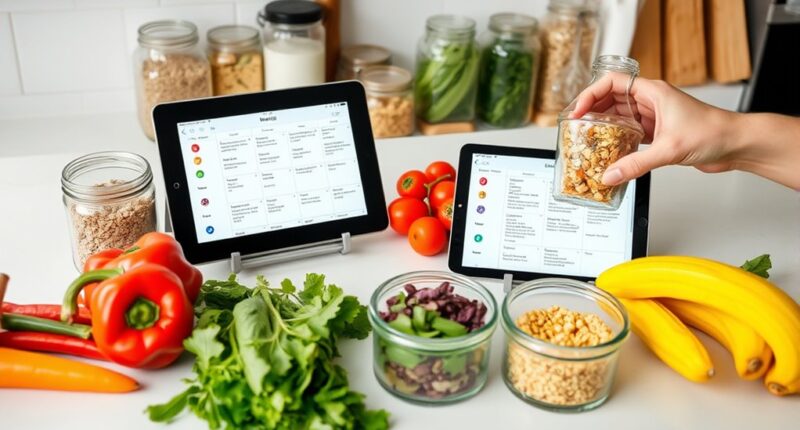Your brain influences meal planning through habits, environmental cues, and emotional triggers, shaping your food choices. Routine reduces decision fatigue by automating mealtime decisions, while mindful awareness of hunger and fullness helps prevent overeating. Your environment, like food placement, can subconsciously guide healthier options. Simplifying choices and overcoming barriers makes planning easier and more sustainable. Keep exploring how these strategies work together, and you’ll discover practical tips for smarter, less stressful meal planning.
Key Takeaways
- Simplify choices by limiting options and planning routines to reduce decision fatigue and enhance consistency.
- Use visual cues and strategic food placement to subconsciously guide healthier selections.
- Recognize hunger and fullness signals to prevent overeating and promote mindful eating habits.
- Develop habits and routines, like prep schedules and grouping healthy foods, to streamline meal decisions.
- Manage emotional triggers and environmental influences to improve focus and reduce impulsive, unhealthy eating behaviors.
How Our Brain Influences Food Choices

Your brain plays a crucial role in shaping your food choices, often without you realizing it. Neural pathways form based on your eating habits and experiences, guiding your preferences and cravings. When you eat something enjoyable, your brain activates its reward system, releasing feel-good chemicals like dopamine. This reinforces the behavior, making you more likely to seek out similar foods in the future. Over time, these neural pathways strengthen, creating habits that influence what you choose to eat daily. The reward system’s response explains why comfort foods or sugary treats often feel irresistible—they trigger a surge of pleasure in your brain. Recognizing how your neural pathways and reward system work together can help you understand your food motivations and develop healthier eating patterns.
The Role of Habits in Meal Planning

Habits play an essential role in shaping your meal planning, often guiding your choices automatically and with little conscious effort. Through habit formation, your brain associates specific behavioral cues with certain actions, making meal decisions more automatic. Recognizing these cues helps you build healthier routines. For example:
Habits influence meal choices automatically by linking cues to healthy routines.
- Eating the same breakfast daily when you wake up
- Reaching for snacks when you feel stressed
- Preparing meals at the same time each evening
- Shopping for groceries on a set day each week
- Consistently choosing healthy options benefits from understanding behavioral cues and their influence on your decisions.
These habits simplify decision-making and reduce stress. By understanding and intentionally shaping your behavioral cues, you can develop positive meal planning habits that support your goals. Over time, these habits become second nature, making healthy eating easier and more sustainable.
Understanding Hunger and Fullness Cues

Understanding hunger and fullness cues is essential for making mindful eating choices. When you cultivate hunger awareness, you learn to recognize the subtle signals your body sends when it’s genuinely hungry. These fullness signals can include a feeling of satisfaction, a sense of fullness in your stomach, or a decrease in appetite. Paying attention to these cues helps you avoid eating out of boredom or emotional reasons. Instead, you eat when your body needs fuel and stop when you’re comfortably full. By tuning into your hunger awareness and fullness signals, you develop a healthier relationship with food and prevent overeating. Over time, this practice supports better digestion, energy levels, and overall well-being.
The Impact of Environment on Eating Decisions

Your environment can critically influence what and how much you eat. The way food is placed, the lighting, and your mood all shape your choices without you realizing it. Social settings also play a vital role in how you decide what’s on your plate. Incorporating cozy textiles and warm color palettes can further promote a comfortable and inviting atmosphere that encourages mindful eating.
Food Placement Effects
The way food is placed in a space can considerably influence your eating choices, often without you realizing it. Food placement and visual cues guide your attention, impacting what and how much you eat. For example:
- Items at eye level are more likely to be chosen.
- Larger packages or containers catch your eye first.
- Grouping healthy foods at the front encourages better choices.
- Less accessible snacks reduce impulse eating.
- Using portion control strategies can help manage intake and promote healthier eating habits.
Lighting and Mood
Have you ever noticed how a cozy, warm-lit room makes you feel more relaxed and perhaps more inclined to indulge? Lighting ambiance plays a vital role in mood regulation, directly impacting your eating decisions. Soft, warm lighting can create a calming environment, encouraging you to savor your meal and eat more mindfully. Conversely, bright, harsh lights may increase alertness but also elevate stress levels, which can lead to impulsive eating. By adjusting your environment’s lighting, you influence your mood and, ultimately, your portion sizes and food choices. Creating a pleasant, inviting atmosphere through intentional lighting helps you stay present and enjoy your meals without distractions. This awareness of environmental influences aligns with emotional and psychological growth principles, highlighting how external factors can shape behavior. In turn, this simple change can support healthier eating habits and enhance your overall meal experience.
Social Influences
Lighting sets the tone for a meal, but the company and environment around you also influence what and how much you eat. Social norms and peer influence shape your eating habits more than you might realize. When you’re with others:
- You tend to eat more to match group behavior.
- You’re influenced by what others are eating.
- Social norms dictate acceptable portion sizes.
- Peer influence can encourage healthier choices or indulgence.
- Sound environment can subtly affect your appetite and eating pace.
Being aware of these influences helps you make mindful decisions. For example, eating with friends who share your health goals can reinforce positive habits. Conversely, feeling pressured to conform might lead to overeating or unhealthy choices. Recognizing the power of your environment can help you align your eating habits with your goals, regardless of social settings.
The Psychology of Meal Prep and Decision Fatigue

You might notice that making meal decisions can drain your mental energy quickly. When faced with too many options, decision fatigue sets in, making choices harder and less satisfying. Simplifying your meal prep process can help preserve your mental resources and reduce stress. Incorporating data-driven marketing strategies such as planning based on nutritional data can further streamline decision-making.
Mental Energy Drain
Decision fatigue can profoundly drain your mental energy, making even simple meal choices feel overwhelming. When your mind is exhausted, you’re more likely to rely on emotional triggers rather than mindful eating. This can lead to impulsive eating habits and unnecessary stress. To reduce mental drain, consider these strategies:
- Simplify meal options to minimize decision-making.
- Plan meals ahead to avoid last-minute choices.
- Recognize emotional triggers that prompt unhealthy eating.
- Focus on mindful eating practices to stay present and reduce stress.
- Incorporate aquatic exercise into your routine to boost mental clarity and reduce stress, helping you make better food choices.
Choice Overload Effects
When faced with too many meal options, mental clutter can quickly lead to choice overload, making decision-making feel overwhelming and exhausting. This overload often results in sensory overload, where your senses become overstimulated by the variety, causing fatigue. As a consequence, you might experience portion distortion, eating larger or smaller amounts than intended because your brain struggles to process the options effectively. Too many choices can also lead to decision fatigue, decreasing your motivation to make healthy selections over time. Having an abundance of options can paralyze rather than empower you, leading to indecision or impulsive choices. Recognizing these effects helps you understand why simplifying your meal choices can reduce mental clutter, making meal planning more manageable and less stressful. **Understanding how decision fatigue impacts your ability to choose healthy options can further improve your meal planning strategies.**
Simplification Strategies
To combat decision fatigue and mental clutter, implementing simple meal prep strategies can make a significant difference. Focus on routines that streamline your choices and reduce daily stress. Here are four effective strategies:
- Plan meals around consistent meal timing to create predictability.
- Use portion control containers to avoid overthinking portions.
- Prepare ingredients in advance for quick assembly.
- Limit variety by sticking to a few favorite recipes each week.
- Incorporate routine-based approaches to further simplify your meal planning process.
These approaches simplify decision-making, helping you avoid unnecessary mental clutter. When you establish a steady meal timing schedule, you reduce stress and save time. Portion control ensures balanced meals without second-guessing. Overall, these strategies support mental clarity and make your meal prep more manageable.
Balancing Nutrition and Convenience

Balancing nutrition and convenience can seem challenging, but it’s achievable with mindful choices. To maintain meal diversity and control portions, focus on versatile ingredients and pre-portioned items. This approach helps you avoid repetitive meals while ensuring balanced nutrients. Incorporating nutrient-dense foods can further enhance meal quality without sacrificing convenience.
Using Routine to Make Smarter Food Choices

Establishing a routine around your eating habits makes it easier to make smarter food choices consistently. When you stick to a routine, you reduce the influence of emotional triggers and cultural influences that can lead to impulsive eating. Here’s how routines help:
Creating consistent eating routines simplifies healthy choices and reduces impulsive, emotional, and cultural eating triggers.
- They create predictable patterns, making it easier to plan healthy meals.
- They minimize decision fatigue, so you’re less likely to choose unhealthy options.
- They help you recognize emotional triggers that prompt overeating.
- They reinforce cultural influences by establishing familiar, balanced eating times and traditions.
- Incorporating mindful practices like music therapy can further enhance your focus and emotional regulation related to eating habits.
Overcoming Common Barriers to Meal Planning

Many people encounter obstacles that make meal planning seem difficult or overwhelming, but recognizing these common barriers is the first step toward overcoming them. Time constraints often lead to rushed decisions, making mindful eating and portion control harder to maintain. To address this, plan meals in advance and set aside specific times for grocery shopping and prep. Fear of waste or leftovers can also hinder planning; start with smaller portions and adapt as needed. Staying mindful during meal prep helps you focus on balanced choices and prevents overeating. Remember, meal planning isn’t about perfection but creating a sustainable routine. Additionally, understanding ethical hacking concepts can help you better secure your digital information while managing your daily activities. By addressing these barriers directly, you’ll find it easier to stay consistent, enjoy your meals, and maintain better control over your portions and overall eating habits.
Simple Strategies to Enhance Your Meal Planning Process

Implementing simple strategies can considerably streamline your meal planning process and make it more enjoyable. Start by creating a master grocery list that covers all your essential ingredients, saving time and reducing last-minute trips. Next, dedicate a specific day for meal prep, so you can batch cook and store meals for the week. Here are four tips to enhance your process:
- Keep a running list of favorite recipes for quick inspiration.
- Use digital tools or apps to organize your grocery lists and meal plans.
- Plan meals around sales or seasonal produce to save money.
- Prepare ingredients in advance, like chopping vegetables or marinating proteins. Incorporating aesthetic home decor elements into your kitchen, such as stylish containers or organized wall hooks, can also make meal prep more enjoyable and visually pleasing.
These strategies help you stay organized, reduce stress, and ensure your meal prep is efficient and enjoyable.
Frequently Asked Questions
How Does Stress Affect My Meal Planning Habits?
Stress can make your meal planning habits less mindful, leading you to choose quick, less nutritious options or skip meals altogether. When you’re stressed, you might also eat more impulsively or rely on comfort foods, which can disrupt your routine. To combat this, practice mindful eating and stress reduction techniques, helping you stay focused on healthy choices and maintain a balanced meal plan even during stressful times.
Can Meal Planning Improve Long-Term Health Outcomes?
Yes, meal planning can considerably improve your long-term health. By mastering meal timing and portion control, you set the stage for better energy levels, weight management, and disease prevention. Imagine a future where consistent, balanced meals become second nature—reducing risks and boosting vitality. It’s not just about today’s choices but creating habits that support your well-being for years to come. Your health’s secret weapon is just a plan away.
What Role Does Cultural Background Play in Food Choices?
Your cultural background influences your food choices by shaping your preferences for traditional dishes and cultural foods. These preferences impact what you find appealing and familiar, guiding your meal planning. When you incorporate your cultural food traditions, you’re more likely to enjoy your meals and maintain healthy habits. Embracing traditional dishes can also make it easier to stick to your meal plan while honoring your heritage, leading to better long-term health outcomes.
How Do Allergies Influence Meal Planning Strategies?
So, allergies don’t just make dinner awkward—they completely rewrite your meal planning. You’ll prioritize food allergy awareness, avoiding known allergens like peanuts or dairy, and get creative with allergen substitution to keep meals tasty and safe. You’ll need to read labels like a detective and prep multiple options. It’s a balancing act, but with a little planning, you can enjoy meals without risking an unexpected trip to the ER.
Is There a Link Between Meal Prep and Weight Management?
Yes, meal prep can considerably aid weight management by helping you practice portion control and guarantee nutrient balance. When you prepare your meals ahead, you’re less likely to overeat or choose unhealthy options. By controlling portion sizes and including a variety of nutrients, you support your weight goals more effectively. Consistent meal prep fosters healthier habits, making it easier to maintain or achieve your desired weight in the long run.
Conclusion
Now that you understand how your brain, habits, and environment shape your food choices, you can start weaving these insights into your daily routine. Picture your kitchen as a well-organized hub where nutritious ingredients await your touch, turning chaos into clarity. With simple strategies and mindful routines, you’ll navigate meal planning with confidence, transforming each decision into a smooth, rhythmic dance that nurtures your body and fuels your day.










